The Spring 2013 Anime Preview Guide
Rebecca Silverman

HENNEKO
Rating: 3 (out of 5)
Review:
There's an old saw that advises to “be careful what you wish for because you just might get it.” Henneko, an abbreviation for The “Hentai” Prince and the Stony Cat, takes that saying and proves legions of grandmothers right. High school student Yokodera Yoto is a pervert, although honestly not all that bad when compared to other shows. He really enjoys looking at girls in bathing suits, the female body – basically if it involves certain areas of a girl, he likes it. But since it isn't acceptable to just blurt out things like, “I'm not here to practice, I just like peeping at the swim team!”, Yoto is forced to keep things under wraps. Then one day his buddy Ponta tells him about how the Stony Cat statue on the hill will take away that which you don't want and give it to someone else, freeing you from whatever you feel is holding you back. For Ponta, the cat took away his interest in sex and left him free to exercise his social conscience. Yoto decides that he will follow his friend's example and go ask the Stony Cat to help him. Unlike Ponta, however, Yoto wants to lose what he calls his “facade,” the filter that keeps him from blurting out the sexual things he's thinking. At the hill he meets Tsutsukakushi Tsukiko, a girl who wants to get rid of her troublesome tendency to show whatever she is thinking on her face. Both make their wishes and offerings (a hugging pillow and a meat bun) and poof! Problem solved.
Or is it just beginning?
What sets Henneko apart from some of the other shows that enjoy objectifying women is that Yoto knows that it's wrong. When he realizes that he is no longer able to hide his thoughts, he is embarrassed, and he quickly becomes the butt of all school jokes. In fact, the premise of the show seems to be not about him using his pervert powers of speech for our amusement but more about him trying to get his lost facade back, because it turns out that in his case getting what you wished for is a lot of trouble. For her part, Tsukiko loses all ability to project emotions, essentially turning her into Nagato from The Melancholy of Haruhi Suzumiya. (Yui Ogura does a very nice job with the change between pre-and-post cat Tsukiko.) She seems less concerned with finding the person who got her emotions, but then again, that could just be because she is now unable to express emotions.
While the show does have plenty of the usual harem trappings – crazy boobs, small angry girl, scenes in the infirmary, etc. – it has an interesting enough twist on the tale to make it an interesting watch. The bright colors and some nice touches like the outline of a cat's head that appears whenever the facade is invoked help to keep things fun, and if the animation isn't always the best, the characters are pleasant to look at and the hugging pillow is a hoot. Those sensitive to male gaze depictions of the female body will still have plenty to complain about, but overall, if you can ignore that, Henneko looks like it might be a fun way to start off your Sundays.
HENNEKO is available streaming at Crunchyroll.
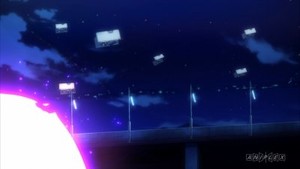
Valvrave the Liberator
Rating: 2 (out of 5)
Review:
It is the 70th year of the True Calendar. 70% of humans live in space, peacefully for the most part. At Sakimori Academy, a high school an undisclosed space location, a group of high school students, including semi-loser Haruto and in-your-face Shoko, are leading a happy high school life with crushes and eating contests and teachers with big boobs. Then one day a group of transfer students arrive, knife the welcoming committee, and discover some sort of lab beneath (inside?) the school. They go on a shooting spree, their cohorts in space launch an attack on the school, and Haruto is sufficiently traumatized to jump into the giant mecha that rises from the ground. He naturally manages to rout the invaders, but now he's some sort of zombie vampire? What the hell?
So you thought Karneval was confusing? Welcome to Valvrave the Liberator. Valvrave really wants to shock you, to play your emotions like a fiddle, and to whet your appetite for more. Unfortunately someone forgot to string this particular instrument, because the overall effect is more confusing than anything else. Most overplayed is the shock factor, which sprays gouts of blood and has teens engaging in acts of violence that are fairly depraved, but ultimately don't work to touch the viewer with their abrupt presentation. Likewise the motivating factor that drives Haruto into the mech isn't one that we have had time to really care about – we met him roughly ten minutes previous and the show did nothing to differentiate his situation from thousands of other similar protagonists'. Sure it's sad, but the whole thing is so rushed that it doesn't make much of an impact.
Valvrave does genuinely try in a few places, most notably with the machine itself. In order for Haruto to activate it, he must accept the loss of his humanity, which could simply be a war metaphor but in the end turns out to be far more literal. (Humorously enough, once he agrees to forfeit his humanity, what looks awfully like a user agreement shows up on the machine's screen.) His broken arm, seen dangling uselessly mere seconds before, now appears to be functional, just one of several bizarre breaks in continuity that plagues this episode. Also worth noting are the blank black screens that crop up a few times, although that could have been glitches in the player.
Perhaps for me the two most memorable moments of the show were at the end when Haruto sobs quietly rather than screaming his anguish to the skies, which was easily more emotionally effective than anything else in the entire episode. Then I felt for him, whereas before I really couldn't have cared less. The other moment was when the villains' ships first appeared. They look like flying toasters from the side. Brave Little Toaster flashbacks aside, it has to be one of the dumbest mecha designs I've seen, and that's including the way that from the front they look like the unnatural spawn of a colossus and a glowworm doll from the 80s.
Overall, Valvrave the Liberator desperately wants you to like it. It wants to be intriguing and deep and full of angst and pathos. All I can say to that is, “Well, at least you tried.”
Valvrave the Liberator is available streaming on Crunchyroll.

Yuyushiki
Rating: 1 (out of 5)
Review:
Based on a four-panel manga, Yuyushiki follows three newly-minted high school girls whose names all begin with “yu”: Yui, Yukari, and Yuzuko. Yui is the stoic, mature one, Yukari speaks sort of softly and is tired all the time, and Yuzuko is like a caffeinated toddler. They meet up, walk to school, and join the data processing club, where they read about the solar system. Yukari and Yuzu also harass Yui by poking her and trying to startle her. If these two were perhaps less annoying, the show might be better, although it would still be thin on plot, but Yukari and Yuzu are so very irritating – it was Rumi Ookubo's Yuzu is also squeaky on top of everything else – that they take what could have simply been a slow show about cute girls and make it into something that can be difficult to swallow at times and dull at others.
Another blow against Yuyushiki is the art. While bodies are fine for the most part, the faces don't fit them, looking too big in terms of the way the features are proportioned. The angles of the jaws add a sort of unpolished look that is at odds with the rest of the show, which while not gorgeous is still less sloppy looking than the faces. When Yukari closes her eyes, which she does frequently, she looks as if someone only drew the top part of her eyes and then forgot to do the whites and irises. There's also a strange amount of focus on characters' laps, and it looks as if next episode will also bring breasts into the equation when the focus on Mom-sensei, the girls' teacher, increases.
Something interesting that Yuyushiki does do is make only the people the girls interact with in color. Everyone else is as detailed as the main players, but uncolored. While many shows have made featureless white or black shadows out of background characters, this style implies that the school is populated by real people, just ones who are unimportant for the purposes of our story.
Perhaps I'm just in a bad mood without really being aware of it, but Yuyushiki more annoyed than amused me. I do have a low tolerance for cute girl shows, but this one really seemed to be scraping the bottom of the barrel for me. Yuruyuri at least looked good. Your opinion may vary depending upon your tolerance for Yuzu and Yukari, but I think that as far as the genre of cute girls doing cute things goes, there are other shows that do it better.
Yuyushiki is available streaming on Crunchyroll.
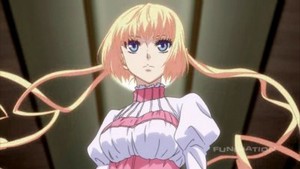
Karneval
Rating: 3.5 (out of 5)
Review:
In an unknown country, a mysterious group called Circus works as a sort of police force to help protect the people. Using magic tricks and acrobatics, the members of this unusual defense force in this episode take on a gang of kidnappers who have hijacked a train carrying a politician and his granddaughter, but before that they seem to be interested in a woman known as Mineh. And who wouldn't be? When we first meet Mineh she appears to be seducing one of the series heroes, a pale red-eyed boy named Nai. Nai, whose hands are chained together, does not appear all that thrilled with the situation and is only too relieved when a thief called Gareki crashes the scene. Mineh, on the other hand, is not happy. This causes her to transform with a series of sickening crunches into a spider-armed, shark-toothed monster. Nai and Gareki run for their lives, only to end up on the train Circus is targeting.
Honestly, it's a little difficult to tell precisely what's going on here. Nai apparently used to hang around with a fellow named Karoku, who vanished into the sea one day. He now wears Karoku's bracelet, which intrigues pretty much everyone who sees it, as does his preternatural hearing. As far as we know, Gareki's just a thief with some tech skills who took Nai in because he thought he could use him. Now that Circus knows about the bracelet and Nai's hearing – not to mention Gareki's skills – ringmaster type Hirato and his acrobatic female companion Tsukumo appear to have an interest in the duo. Oh, and that kidnapped politician? He apparently set this whole thing up to get a look at Circus in action and now he wants to know more about Nai. Was this a prologue? Will the whole show give us this feeling of missing something important? I suppose time will tell.
On the bright side, this looks nice. Movements are fluid when the action is on, bright sparkly colors add interest to darker visuals, and there's something oddly appealing about the bizarre outfits and hairstyles that most characters sport. I'll admit I was hoping for creepier, more circus themed music, but time may bring that about.
If Karneval can start being more of a narrative and less of an experiment in good-looking carnivalism, it could prove to be a captivating show. It definitely needs at least one more episode to decide, but thus far, I am holding out hope. Few things can be more creepily appealing than the circus in fiction – let's see if this one can fulfill its promise.
Karneval is available streaming at Funimation.

Sparrow's Hotel
Rating: 1 (out of 5)
Review:
Sayori Satou protects the Sparrow's Hotel with her innocence, strength, and big boobs! And...that's about it. For a three minute episode, an awful lot happens and nothing at all happens in Sparrow's Hotel. We see Satou flitting around the hotel, keeping room keys warm in her voluptuous bosom, lifting mattresses and messing up freshly made beds by flopping on them, and totally not getting it multiple times. Oh, and she squeezes an apple to make juice for a drunken guest. This show has a serious case of ADHD.
While shorts aren't necessarily known for their stellar animation, this one falls short of even that low mark. Looking like cutouts being moved around on sticks just out of our sight, the characters of this show just sort of appear in one place after being in another, with cuts between poses so as to avoid showing action. It doesn't help that the designs aren't especially attractive, either. Maybe things will improve, but with only three minutes and not much ambition besides showcasing Satou's bouncy (if the show even bothered to animate such things) innocence, it doesn't seem likely.
Sparrow's Hotel is available streaming on Crunchyroll.

Ketsuekigata-Kun
Rating: 3 (out of 5)
Review:
At this point we all know that the Japanese ascribe different personality traits to different blood types. So why not make a show of it? Well, that's precisely what Ketsuekigata-kun does, and the result is surprisingly funny. In this episode, the blood type boys all try and decide how to pursue a romance. A is so cautious as not to get anywhere, B jumps right in without thinking, O creeps everyone out, and AB is...special. Viewers of reverse harem shows will likely get an even bigger kick out of this as each guy is immediately recognizable as this or that stereotype, and depicting everyone as pseudo-stick figures with big round letter heads is a nice touch, as you can impose the anime character of your choice on each of them. At only two minutes, the gag doesn't have a chance to drag on, so this could be one of those fun little bits of goofiness that you look forward to each week. Currently it isn't streaming anywhere – and it is an odd subject, so it isn't hugely likely that it will be picked up, although stranger things have happened – but if you want to wash the bad taste of Amnesia from your mouth, check this out and imagine Toma's face on O. I promise, you'll feel better.

Aiura
Rating: 1 (out of 5)
Review:
On the cuteness scale, there are shows that range from “adorable with distinct plot” all the way down to “cute for the sake of being cute and not much else.” Aiura, I'm afraid, falls into that latter category. At only four minutes long, which consists of roughly two minutes of show and one each for opening and ending themes, it really doesn't give itself much time to do a whole lot. In this introductory episode, one girl skips outside, runs really awkwardly and slowly around town, and sits down to eat ice cream. Another girl bumps the ice cream off the cone with her hip, steals her buddy's taiyaki, and runs off thinking that the first girl is in elementary school. Girl one then comments that she's starting high school tomorrow before biting into the taiyaki and discovering that it has super spicy filling. Roll credits.
If this looked better, a lot could be forgiven, but no one's character design is all that distinct, simply serving to display their roles in the story: kiddy, perky, and maturey. Hands and feet are disproportionately small, and as I mentioned earlier, the movement is jerky and awkward. They also spend the opening theme singing about crab, which at this point is just confusing, although perhaps it's a bit early to count that as a strike against the show. In any event, Aiura looks to me to be cute for cute's sake, and if that's your thing, you're in luck. Otherwise this feels like a little bit of nothing done in soft, soothing colors.
Aiura is available streaming on Crunchyroll.
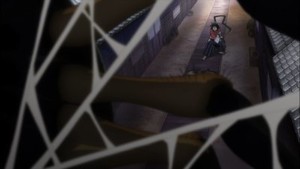
Mushibugyo
Rating: 3 (out of 5)
Review:
In an alternate Edo period, Japan is being ravaged by enormous bugs. They eat bears, people, you name it, and if they're spiders, they spew sticky white gunk on their victims. Young samurai wannabe Jinbei has come to the city of Edo in order to join the Edo Insect Magistrate's Office and protect the world from these vicious creatures and their viscous goo. The only problem is it was his dad who was summoned, not him, and the fox-faced fellow who runs at least the field operations isn't sure he wants some spunky kid and not the seasoned warrior he sent for. Fortunately for the show, Jibei is the typically earnest shounen hero, determined to both prove himself and grow stronger at all costs. It naturally doesn't hurt that there's a lovely, large breasted lady involved, but whatever the motivation, Jinbei won't rest until he has mastered his true power!
While I wouldn't call this good, clean fun, it is enjoyable in a very old-school shounen way. Jinbei is determined, Haru is sweet and supportive, Mugai the Ultimate Hero is sufficiently moody and mysterious, and there's a ninja girl with bombs who wears an anachronistic short skirt with a schoolgirl bow in the back. The show's insistence on dripping spider webbing fluids all over Haru is off-putting (to me at least), as is the focus on her breasts, which get bared as much as possible during her run-in with the giant spider. (There's actually much more fanservice here than in romance-oriented Date-a-Live.) One hopes she'll evolve to do more than get captured and press lovingly against Jinbei's back, but at least Hibachi looks like she's be more interesting, so there is still something to keep shounen-loving ladies from tearing their hair out.
Speaking of hair, everyone in Mushibugyo seems to suffer from an extreme case of Wing Hair, with ludicrously horizontal bangs gracing most heads and ponytails floating off at forty-five degree angles behind them. Likewise the kaleidescope effects that accompany Mugai's arrival are a little weird, but otherwise this maintains a bright, attention-grabbing palate and excitingly animated action.
Overall, Mushibugyo isn't doing anything particularly new or thrilling, but it is a lot of fun. If you're not grossed out by large mandibles and goopy spider gunk, this could be an entertaining brain-break from a busy week. After all, who doesn't love a gutsy kid who carries a sword and doesn't know when to give up? That's part of what makes shounen action so much fun, and Mushibugyo promises to deliver.
Mushibugyo is available streaming on Crunchyroll.

Hayate the Combat Butler! Cuties
Rating: 1.5 (out of 5)
Review:
If you're not up to date with the Hayate the Combat Butler manga, your enjoyment of this latest TV series is likely to be compromised. Why? Well, simply put because the the anime is back to following the manga (more or less) where the previous season did not, thus creating some pretty big discrepancies between the two. Technically speaking, this season takes place before the previous one, when Nagi has lost her money and is running a house she got from her mother as a boarding house.
The action and comedy of Cuties is sadly a bit lacking. It has been advertised that each episode will focus on a different character; next week will be Nagi, but this week is Hayate. While we all know and love the misfortune-prone butler, he's also the character whose point of view we have been exposed to the most, so this was hardly the biggest draw for a first episode. The events follow Hayate as he tries to take care of the myriad girls living in the boarding house (including one non-manga readers will not be familiar with), gets sick, and tries to make it to his exam. While in the past the show has not always needed to rely on exotic gags and locations to be funny, something more than the everyday would have been nice here, as there really isn't a lot to joke about that hasn't been done before in previous seasons. The funniest moments are probably right at the beginning, when Hayate buys some meat and is promptly attacked by a gang of vicious cat thugs, including one with a mohawk. This is genuinely funny; everything is just sort of worth a half smile.
There's something markedly different about the coloring and character designs this time around, although I cannot quite put my finger on it. The sort of flat brightness of everything works for the show, neither enhancing nor detracting, and a fair amount of animation shortcuts look to be taken, particularly in the “show not tell” department. Yes, that's pretty tired advice, but in a few instances within the episode, it would have been nice to see what Hayate was going through rather than just hear about it and see the aftermath.
So yeah, overall, Cuties isn't great. It lacks the hysteria of earlier Hayate seasons, the chronology is off, and Norio Wakamoto's delightfully evil narrator hasn't returned. If you're a Hayate fan who will watch any and everything in the franchise, you may find more to like, but for me, the bloom is definitely off this particular rose.
Hayate the Combat Butler! Cuties is available streaming on Crunchyroll.

Severing Crime Edge
Rating: 2 (out of 5)
Review:
Haimura Kiri really likes hair. I mean, he really likes hair, to the point where there is clearly some sexual subtext going on. He particularly enjoys cutting it, but lest you think this is a dark version of the shoujo manga Beauty Pop, he doesn't seem to like to cut hair because he wants to make girls feel good about the way they look. No, Kiri was clearly the kid who got off on cutting off his sisters' Barbies' hair.
So how does this translate into a show? One day Kiri, who is understandably seen as a bit of an odd-ball at school, overhears some classmates discussing the “ghost with long hair” who lives in a mansion on the hill. Naturally he and his trusty scissors follow the rumors and find doll-like Mushinakoji Iwai, a girl who suffers from a curse that her hair can never be cut. (Lest you think this isn't much of a curse, take it from someone with thick hair who once grew it to her hips – that stuff is heavy.) Fascinated by her mane, Kiri tests out her claim and discovers it to be true. The two are deep in the middle of an unsettling hair encounter (with both of them panting and clearly getting something more out of the situation) when two nasty girls with the bizarre last name of Byoinzaka show up. Clearly there is mutual antipathy between the three females, and when the sisters leave, Iwai explains that they are descendants of murderers and possess something called Killing Goods, which they inherited. Combine that with Kiri's family's shame at his hair fetish, throw in a secret society and a named pair of scissors, and...well, frankly, what you have is sort of a mess. Despite understanding the individual events that took place over the course of the episode, upon finishing it, there is a definite feeling of confusion. Is this a crime show, as the name implies? If so, why throw in the hair fetish? Is there a romance? How creepy will that get? What is going on?
All of this combined with animation that feels a bit mediocre and a rushed pace makes for a less than stellar first episode. The hair thing is strange, but really not that far off the beaten path in terms of anime fetishes – remember the “cuticle detective” from last season? The blatant sexualization of it is more troublesome, mostly because Kiri's in middle school and it feels like we're watching the past of a serial killer, plus it really does distract from the mystery component, assuming from the title that that is the direction the show will ultimately take. While it is conceivable that the show will improve as it goes on, right now it is very confused, and for me at least doesn't have a whole lot to recommend it.
Severing Crime Edge is available streaming on Crunchyroll.

Flowers of Evil
Rating: 5 (out of 5)
Review:
Sometimes something comes along that even though you don't like it, even though it may make you uncomfortable, it is difficult to say that it isn't well done. Flowers of Evil, based on a manga that also made me uncomfortable to the point where I couldn't get through volume one, is just such a show.
This first episode covers, in the grand scheme of things, very little. It serves to introduce series protagonist Takao Kasuga. Although he has a set group of friends, Kasuga gives the impression of being a loner. He reads a lot of classic western literature, his favorite book being Charles Baudelaire's poetry collection Les fleurs du mal, translated as The Flowers of Evil. While we are not given much in the way of Baudelaire's words, they clearly have a great impact on Kasuga, and as the episode progresses we watch a hairy, spiky flower begin to bloom in his heart. Kasuga, you see, has had a crush on his classmate Nanako Saeki for the better part of a year, and at the end of the episode he is presented with temptation regarding her personal belongings. While the episode ends before we know what he will do, the flower finally blooms.
This is not a show for those with a short attention span. The first episode drags on, albeit with a sensation of impending doom created in part by the dilapidated feel of the town and the school and in part by the subtle music. Kasuga goes to school, looks at Saeki, goes home, reads. He talks with his friends. The one moment of upset is when classmate Nakamura (and if you've read the manga, you'll know who she is) calls the teacher a shithead. This breaks the quiet, dull cycle of Kasuga's day and gives us a hint of what's to come.
By far the most controversial factor of Flowers of Evil is its animation. Rotoscoped rather than animated in a more “anime” sense, all of the characters are far from perfect looking, which really works for the story. There's a real teenager feel to everyone, giving the show a realism that helps to drive home the sense of impending doom. It doesn't look nice or pretty or even particularly pleasing, but it absolutely reinforces the creeping evil sensation that the show is working to build. Even if you don't think you'll like it (I didn't) at least watch a little before making up your mind.
Not everyone will like this show. From a personal standpoint, I didn't. But it is one that should be given at least an episode before you form your opinion. Both uncomfortable and fascinating, Flowers of Evil is doing something different, and for that it deserves praise.
Flowers of Evil is available streaming on Crunchyroll.

Arata the Legend
Rating: 3 (out of 5)
Review:
Based on the manga of the same name by Yu Watase, Arata the Legend follows bullied high school first year Hinohara Arata when he switches places with Arata, a young man of the Hime clan in the fantasy world of Awanokuni. The Hime clan is, in no surprise for people who know the translation of the name, the ruling family of this other world, and each princess appears to serve for thirty years. The current princess, Kikuri, however, has been on the throne for sixty, for no girls have been born into the Hime clan during her reign. In order to maintain peace, Arata's grandmother forces him to dress in drag to assume the throne, at least until they can track down a branch family female. While he's not happy about this, he becomes even less so when the Shinsho – sort of magical ministers with special swords called Hayagami – revolt, stab Kikuri, and blame him. He flees into the forest where he switches places with Hinohara, who has just been dealt a harsh social blow. The anime doesn't go into much of his back story, so those who haven't read the manga might be left thinking he's just another overly emotional teen, a definite disservice to the character. Be that as it may, Hinohara suddenly finds himself in Arata's world, where everyone, from his companion Kotoha (a member of the clan which serves his) to his grandmother see him as Arata. Sadly this includes the guys who want to kill him, and Hinohara must find some courage and step up to the plate.
While this isn't as, for lack of a better word, good as the manga, it still retains the fascination of its source material. The Arabian/Asian fusion of the fantasy world is fun to look at, with clothing looking like something from pre-Heian Japan. The idea that we see Hinohara in his 21st century form while all of the others see him as the long-haired boy they know is a bit confusing, but quite interesting nonetheless. The diversity of character designs and colorings is also a nice touch, keeping the visuals, which do occasionally suffer from wonky character moments, worth looking at. The major issue here is that we really don't understand the depth of the bullying Hinohara suffered in his world, and this sadly makes him a much less sympathetic character.
The ending theme is worth mentioning for two reasons: 1) it has major spoilers for later events and 2) it appears to belong to another show. Some of the imagery is really bizarre in context and it is also rife with amusingly homoerotic moments. The rock sound is a little weird, but better than some of the incidental music, which treads decidedly melodramatic ground.
Overall, I enjoyed Arata the Legend's first episode. It has fantasy, interesting cultural and visual aspects, and looked pretty good. If you've read the manga, you'll probably like the hero better, but otherwise, this looks like a safe bet for fantasy fans.
Arata the Legend is available streaming on Crunchyroll.
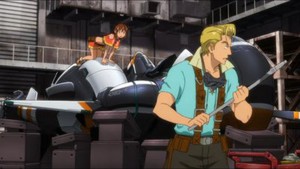
Gargantia on the Verdurous Planet
Rating: 3.5 (out of 5)
Review:
Many years from now, the Earth as the birthplace of humanity has passed into legend. Space-dwelling humans are currently occupied by fighting a war against a race known as Hideauze, who apparently have a floral form. When not engaged in military service, people live in the paradise known as Avalon, and young soldier Ledo has just been informed that after he completes this battle, he will be permitted four weeks on Avalon to eat, sleep, and reproduce at will. Ledo's surprisingly not all that thrilled with this, possibly because he has seen this kind of show before and knows that getting good news like this usually means that something is going to go terribly wrong. Long story short, Ledo's group is overwhelmed by the Hideauze and Ledo himself misses the jump gate back to the main ship, flinging him into the cold depths of space. His sentient mecha, called a Machine Caliber, puts him into a cold sleep...Six months later, Ledo and Chamber (his mech) have been picked up by a primitive group of people who speak a strange language. They have no idea what Chamber is and are busily trying to open it when perky young thing Amy and her pet chirrell Grace, who looks like a combination of a chipmunk and a squirrel, come bounding onto the scene. Amy's really curious about the mysterious object, but things go downhill when Ledo comes out and kidnaps her. Racing around the ship, Ledo is stunned when he goes outside and finds himself not on a spaceship, but on an ocean going vessel. Earth, it would seem, is no myth.
This show has a lot of potential, at least from the second half. The first half is a pretty basic space battle, with lots of ships shooting at each other, intricate battle formations, and those weird floral space enemies that crop up in anime from time to time. As a way to introduce Ledo and his worldview, it works, but it's when he gets to the titular Verdurous Planet that things pick up. A fish out of water story is nearly always interesting, and this one seems to have its hero going from a sci fi world to one that to him seems like fantasy – outdated technology, honest-to-god water, weird fuzzy animals...he's utterly out of his element. It seems possible, and perhaps even likely, that he and Amy will develop a Sousuke/Kaname relationship as the show goes on, and their personalities certain seem to be geared towards it, with her all emotions and him all cold-blooded military strategy. Luckily there are some nice touches here, such as the fact that Ledo's version of the language has clearly evolved differently from Amy's. When they speak to each other, there's just enough of a similar sound to make it confusing for the characters (and viewers), and some of Chamber's translations are very funny as he gets the textbook meaning but not the nuance of Amy's insults.
All of the Earth characters have distinctly different appearances, which is mostly striking because the other soldiers we saw all looked vaguely similar to Ledo, thus drawing an interesting line between the two societies. The show also uses very different colors for both halves, and even for the characters themselves. Ledo dresses all in dark shades (except for the Tron-esque lights on his suit) and has fairly washed out coloring, while Amy and the other people on her ship have bright hair, loud clothes, and more of a sense of barely contained energy. These are people who are actively living, while Ledo is only doing as he is told, giving us an interesting premise for the story.
Even if space battles aren't your thing, sit through the first half of this to get to the second. Not that the space battle isn't interesting in its own right, but it feels very much like the set up it is, very cut and dry. With Ledo's arrival on Earth, the story gains emotions and a bit of quirk, and I for one am looking forward to seeing where it is going.
Gargantia is available streaming on Crunchyroll.
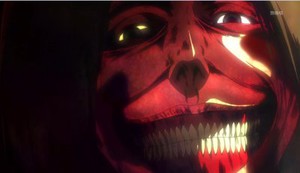
Attack on Titan
Rating: 4 (out of 5)
Review:
Titans: enormous humanoid creatures with no apparent gender and a taste for human flesh and bone. In order to escape their voracious appetites, humans have built walled cities and lived behind the stone safety of the their protections for at least on hundred years. Every so often the men and women of the Recon Corps venture outside to try and attack the Titans, but it is no use – groups come back battered, bleeding, or not at all. Young Eren sees the humans' existence as merely being livestock waiting in their pens, and he dreams of joining the Recon Corps with his friend Armin. His mother is adamantly against it, but his father, a local doctor of some renown, seems strangely accepting of his son's wish, and before he leaves to treat a patient promises to show Eren something in his “secret basement.” Before that can happen, however, an especially large Titan all but bare of skin over his musculature breaches the wall. Titans, grinning their fixed, terrifying grins, enter the town and begin to pick off villagers one by one. Eren and his sister (?) Mikasa run to try and save Mother, but it is no use. As they are carried away by a town defender, Eren watches his mother get eaten by a Titan as her blood sprays down upon him.
Fee fie fo fum, indeed.
Attack on Titan is both gorgeous and appalling in its visuals, juxtaposing idyllic pastoral landscapes with scenes of unimaginable cruelty and bloodshed. The perpetually grinning visages of the Titans, to say nothing of the satisfied look on one's face as he eats Eren's mother, might have been pulled directly from someone's nightmares. The contrast of dark red blood and the otherwise earth-toned color scheme helps to highlight the horror, and the animation emphasizes all the right things – the flop of the recently deceased, the flight of masonry – in order to drive the shock home. It's actually an excellent mix of what 18th century Gothic novelist Ann Radcliffe defined as horror versus terror: the one is physical, making you want to look away, and the other is intellectual, making you want to know what's going to happen next. Whether you like this kind of violent story or not, Attack on Titan is difficult not to pay attention to once you start it.
While this first episode is clearly a prelude to the main story to come – which looks to involve some really neat technology for swinging around the forest – it does what any good beginning should: pull you in. Even as the person who has to cover her eyes (or take her glasses off) during scenes of intense gore, I found it hard not to be sucked in to this intense world. The music absolutely helps here, as it informs the mood without being overwhelming or melodramatic. If the opening theme goes on a hair too long, it can be forgiven because the rest of the music is so spot-on. Overall this is a grim, fascinating story. The violence is intense and the monsters are terrifying, but once the show sinks its huge, bloody teeth into you, it doesn't let go.

Muromi-san
Rating: 3 (out of 5)
Review:
One day unassuming young lad Takuro is fishing on the pier when he feels a tug on his line. Like any good fisherman, he reels it in, only to discover that he's caught not a fish, but a mermaid with a taste for ragworm. Her name is Muromi, she has a very sad excuse for a tail, and she's here to make Takuro's life if not a living hell then at least substantially more annoying.
Fortunately what's annoying for him is amusing for us. Muromi's no Ariel despite the seashell adornments, and she not only eats Takuro out of bait but also has to have him pull multiple fishhooks from her mouth, throws a jellyfish in his face, and, in surprise gesture, asks him to fertilize her eggs, which are in a pile on the pier. The whole thing takes place with minimal artwork and with most of the visuals centering on Muromi herself, who must be related to Lina Inverse if her eyes are any indication. At only twelve minutes, Muromi-san on the Shore never pauses for breath, flying from one gag to the next and never addressing the mystery of how she manages to swim with such bedraggled fins. In a longer show or at a slower pace, this could be annoying, so the shorter episode was definitely a good move for this one.
Perhaps the easiest way to sum this up is to compare it to last season's Senyu. While the topic is different, it maintains the same manic energy and sense of absurdity. Muromi may look like the girls of Mermaid Melody Pitchi Pitchi Pitch, but trust me – she's no innocent young thing. The fact that she tramples all over our Disneyfied ideas of what a mermaid should be gives this show a bizarre, entertaining appeal. It could get old fast, but for one episode at least, this is a lot of silly fun.
Muromi-san is available streaming at Crunchyroll.
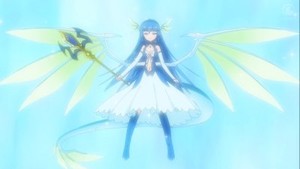
Zettai Boei Leviatan
Rating: 3 (out of 5)
Review:
Some time ago, a meteor descended upon the magical elfland of Aquafall, releasing sparkly purple badness upon the world. Then, apparently, everyone forgot about it and went on living their lives. Water magic user Leviatan is trying to master her spells, which apparently she used to be quite good at. After her older brother's mysterious disappearance, however, she seems only able to use them if she enacts a magical girl transformation, whereby she gains, wings, a tail, and a pretty dress. One day while practicing she accidentally shoots a small fairy out of the sky. The fairy, who goes by the name of Syrop, isn't upset, though – it seems she's been looking for members of the Aquafall defense force she wants to found, and Leviatan is just perfect. But before they can talk shop, Syrop really needs to eat. She's starving.
Meanwhile two other color-coded young ladies who presumably have like powers are also going about their business. Rosy colored Bahamut is busy confronting thugs in town who are harassing a young horned woman (“They tried to look at my scales!”) when Syrop sticks her nose in and makes things worse. Earth-toned Jormungand is working as a deliverygirl when she takes a break in order to have some lunch. She's just about to dig in when the thugs Bahamut annoyed and Syrop incited start a brawl and destroy her meal. The four girls presumably beat the thugs in a bar fight, introduce themselves on a lovely hilltop, and the episode ends. Oh, and Syrop is still hungry. Apparently fairies can really eat.
Clocking in at only twenty minutes and a bit light on the plot, Zettai Boei Leviatan is nonetheless a fun little confection. Sure it isn't anything hugely innovative, but the candy-bright colors are nice to look at, each character has his or her own distinct look, and the obsessed Tokyo Mew Mew fan I once was likes the animal attributes at least Leviatan gains after her transformation. Syrop may prove to be a tipping point for people, as the floaty little instigator could turn into a major annoyance if she doesn't acquire some more traits. The same could at this point be said for Levi, as she's pretty bland throughout, but both Bahamut and Jormungand show some promise, particularly the former. The animation has a weird moment when each girl is whapped by a large bug that is clearly 3D, but other than that it looks decent. Overall, this was a cute, amusing introduction to what I'm hoping will be a goofy fantasy story. There's no depth, but as we all know that can change, though even if it doesn't this could still be a fluffy little bit of fun.
Zettai Boei Leviatan is available streaming at Crunchyroll.
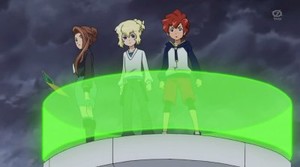 Danboru Senki Wars
Danboru Senki Wars
Rating: 2 (out of 5)
Review:
How do you like your toy commercials – quick and between the program you're watching, or twenty-three minutes long with a nominal plot? Danboru Senki Wars, technically a sequel but more in the sense that it's set in the same world as its predecessor, is the latter – a half-hour toy ad that nonetheless makes an attempt at being an interesting show. The story takes place in 2055, a time when LBXs, controllable mecha models that are used to battle, sort of like a 3D card game, have become the most popular hobby and entertainment media in the land. Bright eyed and bushy tailed Arata has just gotten accepted into the school with the most prestigious LBX team and is just raring to go. (He also apparently got dressed in the dark.) His enthusiasm remains undimmed when the school greets him by telling him to leave all LBXs and other electronics at the gate and doesn't allow him to introduce himself to his new classmates, who seem more invested in giving him death glares than anything else. When his dead-eyed homeroom teacher explains to he and fellow new kid Hikaru that as part of the curriculum they must participate in war games, he takes it in stride. Simulated battles that are supposed to help the UN decide how LBX wars would pan out globally? Sure! Why the hell not?
Adult viewers, who admittedly are far from the show's target audience, are likely to have a little trouble with this set-up, although there is an inherent amusement in the fact that the UN seems to think that middle school students are the emotional equivalent of world leaders. The whole idea of forcing students who enrolled because of a sport (more or less) to use that game to practice killing in a real-world situation is kind of uncomfortable, although I doubt that the ten year old boys the show is clearly meant for would think so. Like I said, this is more a grown-up problem than a kid one.
The show is an odd combination of freaky and interesting in terms of visuals. Arata clashes horribly with himself and everyone around him, one of his classmates appears to have reds of his eyes instead of whites, and some old guy looks like the fellow from The Velvet Room in Persona 4. The LBXs themselves are cute in a weird way – they're like pudgy little mecha kids who move around on heelies. The contrast between the sterile backgrounds and the manically colored people is neat, and the animation is surprisingly smooth for the most part. The music, on the other hand, is far too epic for its context, giving the impression that the show is taking itself way too seriously. This overuse detracts occasionally, as in its quest to be dangerous and serious it shoots on by and lands somewhere between ridiculous and melodrama.
All in all, this is a kids' show. If you like that – and I admit that I often do – then check it out. But if you can't shed your adult mindset for half an hour, then you may as well not bother.
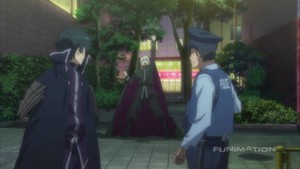
The Devil is a Part-Timer!
Rating: 3.5 (out of 5)
Review:
Satan has come from a distant world to work at MgRonald's! Actually, Satan and his minions were trying to take over that distant world, but they were defeated by the humans, most particularly a hero named Emilia. When Satan realized that he couldn't win against her – it took getting one of his horns cut off for him to come to that conclusion – he fled, vanishing through a Gate to another world. That world, as it turns out, was modern day Japan, and it seems that one of the major side effects is that he and his minion Alciel now both resemble teenage human boys. Lost, confused, and speaking their own special language, Satan realizes that he can use some magic, but it won't be enough to help them survive. What's a devil to do? Register as a Japanese resident, forge a name stamp, and find part time work at a fast food restaurant, apparently.
The Devil is a Part-Timer is thus far the funniest show to appear this season, if you don't count the unintentional humor of UtaPri2. The zeal with which Satan, who has renamed himself Maou Sadao to better fit in with the humans, commences his job is zany and contagiously entertaining, particularly as we watch him do good deeds in pursuit of it. (“Let me warm up your baby food in our microwave, ma'am!”) His fast acceptance and embrace of human culture is also quite entertaining, although poor Alciel, now Akiya, wonders how on earth they're going to survive on burgers, fries, and magazines until payday.
As a production, the show has some nice touches. The language that Satan and Alciel speak upon arrival sounds a bit like a mixture of German and Russian, and has a noticeably different grammatical structure and accent than Japanese. The two converse in it exclusively until about the eight minute mark, where some narration begins. At this point the dialog is switched to Japanese, but it returns to their own language when they begin interacting with Japanese speakers. (Satan's first attempts at Japanese are pretty funny.) The first few minutes of the show before the two come to Earth are visually and stylistically different from the rest of the show, with a dark color scheme and some intense violence, which naturally makes Maou the happy part-timer an even more amusing contrast to the vicious monster of the first three minutes. The animation can get a little patchy in places, but it is the dialog that carries this show, with only a few sight gags (such as Satan's winning smile) coming into play.
If you're lamenting the end of Ixion Saga DT, this might fill the gap for you. Mixing absurd humor with some very clever storytelling devices, The Devil is a Part-Timer's first episode promises to be a fun ride.
The Devil is a Part-Timer is available streaming at Funimation.
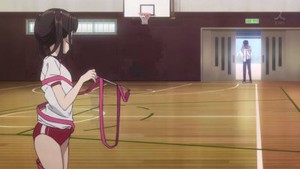
Photo Kano
Rating: 1 (out of 5)
Review:
I seem to be giving a lot of low ratings thus far. Probably that has to do with the fact that some of the harem shows have been treading ground that for me at least makes them seriously distasteful. While harem has never been my favorite genre, it generally just doesn't appeal to me rather than provoking the sense of disgust that Photo Kano does with its even more blatant than usual objectification of the female body.
Based on a PSP romance game, Photo Kano is the story of how Maeda Kazuya gets his father's old digital camera and suddenly sees all girls as photo subjects. But not their faces, oh no – after he makes that statement, the camera pans around the school, showing us precisely what Kazuya means: legs, a flash of underwear, cleavage, basically girls' bodies below the neck. The addition of the camera to this otherwise fairly normal portrayal of the female form in this type of show makes for a more uncomfortable experience, at least for me. Kazuya's female classmates are no longer people – they are subjects when seen through the viewfinder. This is further compounded when our hero meets Kudou, the president of the Photography Club. Sporting a really weird pseudo-mullet, Kudou introduces his philosophy that photos should be borderline erotic in order to be art. He also presents his club members – the guy who specializes in upskirts, the guy who specializes in downshirts, and the girl who takes secret stalker photos. At this point Katsumi, the president of the rival Photo Club, comes in and offers Kazuya membership in her less prurient (and notably all female) club. Guess which one Kazuya goes with?
It doesn't help matters that this show makes its origins painfully obvious. From the stock character nature of all of the girls to the fact that everyone has an interest in the hero, however slight, and this includes his little sister, everything about Photo Kano screams romance game adaptation. Animation can get pretty choppy and lazy at times, most notably when nubile young student Mai is doing her rhythmic gymnastics routine, which honestly looks pretty bad. Other than that, the show is much more interested in the flutter of a skirt than the everyday dullness of someone walking. On a more positive note, Hikaru Midorikawa as Kudou is spectacularly creepy during the preview, so there may at least be some quality voice work to look forward to.
Naturally just because this show doesn't appeal to me – and turning the main girls into flowerpots at the end sure doesn't help – that doesn't mean that it won't appeal to everyone. On the other hand, even if we discount the creepy vibe I got, the animation is less than stellar and the premise is thin. Surely there will be better harem shows for the fans – this one isn't quite cutting it.
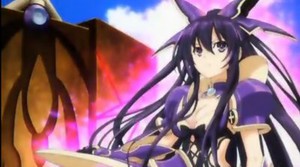
Date A Live
Rating: 1.5 (out of 5)
Review:
Thirty years ago, a mysterious series of events known as “spacequakes” began devastating the earth, with the most significant in East Asia. Now that these are a regular occurrence, cities such as Tenguu, where our everyboy protagonist Shido lives, are essentially built on elevator platforms, so that important pieces of infrastructure and shelters can be lowered underground in case of a quake. So life is, for a given value of the word, normal. Shido, a sixteen-year-old high school student, lives with his sister Kotori, who seems to love him lots and lots. Their parents conveniently absent, the two live an idyllic lovey-dovey sibling life, going to school, teasing each other, and generally being way too cute for their own good. Naturally this has to end.
One day Kotori, in an apparent bid to be the world's stupidest and most annoying fourteen year old girl, makes Shido promise to take her to a diner for lunch after school. “Promise you'll come even if there's a spacequake!” she pouts adorably. Shido agrees, then goes off to school with his possibly bi friend, who does a bang-up semi-offensive stereotype, where he encounters the emotionless quiet girl with pale blue hair and the improbable name of Origami and his way too childlike teacher. All of a sudden, spacequake! As he's going to the shelter, it occurs to Shido that his sister is dumber than a brick, so he checks her GPS location on his phone. Sure enough, Kotori's at the diner. So off our intrepid hero runs to rescue her, only to find himself confronting a purple-haired girl in a battle gown who seems to think he wants to kill her. Shido may not want to, but Origami and her battalion of battle babes sure do as they swoop out of the sky in trademark anime war leotards. Next thing Shido knows, he's on a ship talking to a lady with bags under her eyes and his little sister is not who he expected. In fact, she seems to want him to play some sort of living dating sim to help defeat purple girl. And thus a slim premise on which to base a show is laboriously established.
If Date-a-Live didn't cloak itself in a first episode full of war themes and fantasy versus sci fi imagery, the end result might not have been so flat. Not that it does a spectacular job of covering up the fact that it's a harem with a slightly different plot, but the set up for it feels overly ambitious. This is not to say that the show can't evolve into a more interesting version of itself, but right now it feels very contrived and pulls in a few too many stock characters, although thankfully no one is wearing an eye-patch yet. Some of the character designs are quite lovely, particularly purple girl, whose eyes are striking, even if she looks like a Saber knock-off. The fanservice is fairly low at this point, which is surprising, with only flashes of Kotori's underage undies and one butt shot right now. Purple girl certainly shows a fair amount of cleavage, but there hasn't been any bouncing or focus on it yet. While this could just be because the show is more A than T, it also suggests that perhaps fanservice won't be the absolute focus as things progress.
All in all, this really wasn't very good, but it was also clearly set up, and non-harem fans might yet find something to enjoy here. Honestly, if Date-a-Live spent more time being what it wants to be (harem) and less on contrived set up (sci fi), it would probably be a whole lot more enjoyable.
 Yahari ore no Seishun Love Come wa Machegatteiru
Yahari ore no Seishun Love Come wa Machegatteiru
Rating: 1.5 (out of 5)
Review:
The winner of “Most Unwieldy Title” for this season, Yahari Ore no Seishun Love Come wa Machegatteiru, or My Youth as a Romantic Comedy is Wrong as I Expected, pairs unlikeable characters with a dull first episode to create what was a singularly unimpressive debut. Based on Wataru Watari's light novels, the story follows three absurdly named high school students as they...as they...well, in this episode, two of them, male lead Hikigaya Hachiban and surly girl Yukinoshita Yuki, sit around in their empty club room and spout preachy philosophy at each other. Then perky and bosomy (with bonus pink hair!) Yuigahama Yui bounces in and needs them to help her make cookies. Because she can't cook. That's still hilarious, right? Anyway, they help her, preach some more, and the episode ends with it looking like Yui has a crush on Yuki, because they have to make this story interesting somehow.
The sad thing is, the premise of Hikigaya, adorably nicknamed Hikki by Yui, because that's what characters like her do, resenting all of the hype about high school being the best time of your life is a good one. There are so many shows, harem or otherwise, that play up the glories of high school as the ultimate fun time, that focus on the joys of “making memories” and “enjoying our youth” that it would be refreshing to see a show where someone cries foul about that. But instead we find tired old devices – school club built around helping others, one guy and multiple girls, polar opposite female leads, meddling teacher in random lab coat – coupled with two protagonists who really aren't at all endearing. The teacher, Hiritsuka-sensei, is also an irritant, as she forces Hikigaya to join Yukinoshita's club because she doesn't like his essay about how the glories of high school and youth are all a crock. If you're concerned about a student's emotional well being, you talk to him, not make him do community service, lady. There are also a few problematic gender issues to be found in the first episode, with Hikigaya calling Yui a bitch repeatedly simply because she is female and during the cookie baking, Yukinoshita tells him that the only way he can help is by tasting the end product. I may be over-reacting, but both of those, particularly the first, which he says in English, so this isn't a subtitle issue, really bothered me.
The color palate used for this show is perhaps best termed “muted,” although “washed out” would also work. Characters spend most of their time sitting or standing in various sparse locations talking, so there really isn't much in the way of animation to critique. Flashbacks are done creatively, as if they were old filmstrips being played on the kind of projector now collecting dust in attics, but other than that, it's pretty lackluster.
That, actually, is the word I would apply to this show overall. Lackluster. It's preachy, slow, vaguely offensive in places, and none of the protagonists are likeable. Next show, please. I'm ready to move on.
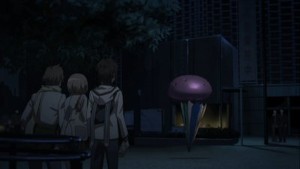
Devil Survivor 2 The Animation
Rating: 4 (out of 5)
Review:
What if you could register on a website to see your friends' dead faces just before they die? Sure it sounds ghoulish, but it's just a game, right? C'mon, all the cool kids are signing up for it! That's essentially the line that high school student Hibiki's friend Daichi feeds him before signing him up for Nicaea, a strange web service that claims to send you a video of your dead friends before they actually die. The site is hosted by an evil bunny girl, so obviously the whole thing's some kind of joke, right?
As you may have guessed, wrong. Daichi and Hibiki are joking about Daichi's crush on Nitta, a girl who goes to their school, when suddenly they both get emails from Nicaea. The emails contain links to videos of their deaths in the very spot they are currently standing in. Just as the boys are uncomfortably leaving the station, some sort of disaster strikes, a train derails, and they both die. Or do they? Nicaea's bunny girl mascot shows up and offers them both the chance to live. When they take it, she installs some sort of devil summoning app on their phones, giving them the tools to ensure their continued survival. In the interest of gender equality and a possible romantic subplot, Nitta receives the same offer. When the three revive, the bodies of the dead are being preyed upon by giant wolfmen. Good thing bunny girl gave them the power to summon demons of their own...
Let me go on the record as saying that I have not played the game, so I cannot speak to whether or not this is a good adaptation. I will say that at this point it does not feel like a game adaptation in the sense that you at no point have the sensation that you are watching someone else play. In fact, Devil Survivor 2 The Animation comes off as an exciting survival tale with high stakes and a few moments of very real fear. Small hints as to what may really be going on are scattered around, including the possibility that a death can be avoided, so there's a lot to take in and think about. The animation looks nice and if the characters themselves aren't all that remarkable to look at, the monsters are another story. They range from terrifying to carnivalesque to cuddly, which is an impressive range. Supernatural buffs will recognize them as coming from several different mythologies, which is also a nice touch. Right now the major thing dragging this episode down is the Mysterious Group in military uniform who Know Things. Claiming to be from a meteorological society, a spectacularly bad cover up, they stalk around saying cryptic things and asserting control without bothering to really explain. Had they been saved for later or not played their part in so heavy-handed a manner, they'd have worked much better.
One more thing of note is the backgrounds. The transformation from the everyday world to one of total chaos and destruction is both swift and impressive. From the choppy image on a shattered screen to people clutching their useless cellphones, the image of a modern apocalypse is very effective; in fact it reminds me a lot of descriptions I've read of the Great Kanto Earthquake in the 1920s. So whether you've played the game or not or have a bias against games turned into television shows, do check out Devil Survivor 2 if only for the atmosphere. And also please congratulate me for resisting the urge to make a “there's an app for that” joke for this entire preview. It perhaps says something about how engrossed I was in the episode, and that can only be a good thing.
Devil Survivor 2 the Animation is available streaming on Crunchyroll.
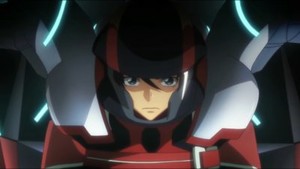 Majestic Prince
Majestic Prince
Rating: 2.5 (out of 5)
Review:
Space: the mecha frontier. The Undina Base is being attacked by large green men known as Wulgaru, although we aren't sure why. The decision has been made to abandon the base when a man named Simon who would have been played by Arnold in the 1980s comes in. He gives the camera an enigmatic look before the scene cuts to a group of five student mecha pilots failing a training exercise. Officially called Team Rabbits (because Team Kittens was taken) but better known as Fail Five, these kids all have ambition, but for whatever reason just can't work well together. Maybe it's because Izuru is always drawing or Tamaki is constantly lovesick; in any event, their track record is not good. Imagine their surprise when Simon summons them to jump aboard real mechs and go out to help the beleaguered Undina Base!
If anime has taught us anything over the years, it is that when science fiction war strikes, the fastest way to take care of it is to throw some teenagers in vaguely humanoid weapons and sic them on the enemy. Majestic Prince really doesn't do much to stray from this formula, although making artist Izuru the team leader is a nice touch, as is the mixed gender group. Otherwise this has a very familiar flavor, and it isn't even particularly compelling as opening episodes go. The contrast of bright colors with the darkness of space is visually interesting, and the fact that the effort was made to give each mecha its own characteristics is another nice touch, but the battle scenes aren't terribly exciting and none of the characters really grab you. Izuru quickly loses his unusual qualities when he proclaims that he wants to be a hero, although the fact that the rest of the gang clearly thinks this is a stupid wish helps to alleviate the feeling of “been there, done that.” The preview seems to indicate a much more action-packed second episode, however, so this opinion is definitely subject to change.
The character designs are just odd enough that they deserve a mention. Noses appear to have vanished for most of the players, with the notable exception of Commander Smith aboard the Undina, who has an enormous schnoz. All of the Fail Five have flat heads and Tamaki is also cross-eyed for most of her scenes. Is this her character design or the mark of cheap animation? The consistency is remarkable on that front, but it does beg the question of why someone cross-eyed would be allowed to pilot dangerous machinery.
I suppose that my best advice on this show would be that if you enjoy mecha that's one of the genres where you don't mind retreading some familiar ground, this might work for you. So far it isn't great shakes, but we all have our favorite genres. If this is yours, do give Majestic Prince a shot.
Majestic Prince is available streaming on Crunchyroll.
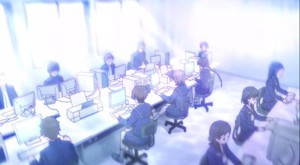
Red Data Girl
Rating: 3 (out of 5)
Review:
Izumiko Suzuhara is a girl who wants to change. Quiet, unassuming, and apparently shy, Izumiko lives at a mountaintop shrine deep in the countryside. Her father is in America and shows no signs of returning. Her mother is simply absent, but before she left, she plaited Izumiko's hair into two long braids, a style that she has kept ever since. One day, the day the story begins, she dares to cut her bangs.
This is the change that seems to start the story. For some reason everyone around her, particularly those at the shrine, are aghast that she has done such a thing. A boy at school teases her, though another, apparently Izumiko's secret crush, tells her that it looks nice. Her friend Harucchi is supportive, even helping Izumiko with her computer assignment. But when another classmate makes a nasty comment, Izumiko decides that she's going to do her research herself and takes charge of her computer...only to find that the classroom has filled up with water only she can see and feel. The computer suddenly connects her to her absent father, and until she panics, everything is weird, but fine. Once she gets worried, however, Izumiko thinks, “I have to shut off the power!” and lo and behold, every single computer in the room ceases to function. Does Izumiko have some sort of strange mystical strength?
As a first episode, Red Data Girl's is interesting without being fully intriguing. Izumiko is a bit bland at this point, although the way she has clearly been sheltered for her entire life does help to explain that. The absent parent routine is one that has been overdone since the Orphan Fantasy first became a thing in literature, with the guardian with a surly child the heroine's age being pretty hoary in anime history. That Miyuki, the son in question, seems like a total jerk who enjoyed tormenting Izumiko when they were children, adds some danger to the tale, so this definitely has potential. The lush rural backgrounds, dull, almost monotone color palate (with the notable exception of Izumiko's red glasses, which is visually a nice touch), and gentle animation, this looks nice enough, and the ending theme makes interesting use of fans. Since the source material is by Noriko Ogiwara, author of The Good Witch of the West, there's an excellent chance that things will pick up as the show goes on. As of this moment, Red Data Girl has the potential to go places – it just hasn't taken very many steps on its journey yet.

Uta no Prince Sama Maji Love 2000%
Rating: 2 (out of 5)
Review:
Are you ready? Let's song!
The beautiful candy-colored boys of the campy Uta no Prince-sama are back, along with ol' Mountain Dew Laser Eyes Haruka, the crazy principal, assorted teachers, and Haruka's slightly-too-friendly former roommate Tomo! Now Haruka and the boys have graduated from their performing arts high school and made their debuts as professionals, so in order to make sure that they keep on drawing in crowds, everyone has enrolled in the Master Course. We're not told precisely what that is, apart from a way to keep the gang together in a similar setting while still advancing the plot; it seems to be a sort of associate's degree in being an idol. This first episode is mostly concerned with reintroducing all of the characters, making sure we remember who has the hots for Haruka, and of course introducing a few new guys. You see, in the Master Course, young idols are paired with an older group who will serve as mentors, and for the original six of Starish, that's a more seasoned trio of singers. The Starish boys are split into three pairs, with each getting a different member of the other group as a mentor...who will live with them. Needless to say, this last bit does not go well.
The opening is, of course, another bouncy, vaguely bizarre Jpop number by Starish. What is most remarkable about it is that the dancers are all animated traditionally rather than using the motion capture 3D that Love Live chose. Not only is this more impressive, it also is easier on the eyes, even if the pelvic thrusts can never be unseen. Other than that, the animation looks to have taken a slight downturn from the previous season, although it is still far from shoddy. The show retains its manically bright palate so that when a new character with brown hair and grey eyes shows up, it's almost jarring to see something so subdued. (He also looks like Rinko Ueda designed him, which is odd.) Those who have been watching last season's Amnesia will be immediately struck by how much Haruka has to say and how she actually reacts to things. This is an improvement from the first UtaPri, which had her pretty firmly in her shell, and it bodes well for her character.
Perhaps the most disappointing thing about UtaPri 2 is simply that it is not on Nico Nico and so there are no comments. Naturally one can make them to oneself, but I can tell you that my dog was singularly unimpressed by my wit, and it just isn't the same. And yes, the out-and-out cheese of the show is harder to take sans commentary. But if you enjoyed the first season, it is still worth giving this a try. There may not be comments, but it still has all of the elements that made the first UtaPri so wonderfully, cheesily, bad. In a good way.
UtaPri 2 is available streaming on Crunchyroll.
discuss this in the forum (1134 posts) |
this article has been modified since it was originally posted; see change history
back to The Spring 2013 Anime Preview Guide
Season Preview Guide homepage / archives